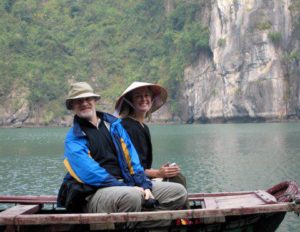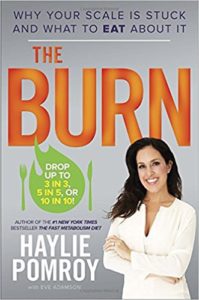
I mentioned in my previous post that we had met with Michael Broffman at the Pine Street Clinic to get our protocol during the “cyberknife” treatment and as an overview for what we need to think about not only at Sanoviv, but also into the future. Pine Street Clinic has specialized in evidence-based integrative medicine since 1982. These are my notes from that meeting, which I think are incredibly instructive for the “New Normal After Cancer.”
Broffman advised us to treat our month at Sanoviv as a place to get into a routine….to learn the curriculum and then carry it back in a “return home” program. He strongly suggested sticking with Sanoviv’s meal program – mostly vegetarian with low net carbs. He said that our follow-on plan should involve committing to, for 24 months after returning from Sanoviv, eliminating red meat, pork, lamb, etc. (whether or not organic/grass fed). Basically to stick with chicken (if 100% sustainably sourced), eggs (same), and seafood (ditto). He advised us to eat what we have in the freezer now (which we are – we are calling these two weeks our MeatFest(TM)!) 😉

Broffman reiterated that the Quantity that we should consume is directly related to Fitness. So, on any day we’re “desk bound,” we need to stay Vegan on that day. If we’re doing Strength work, we can have some animal protein. (There’s more below about “Fitness.”) That said, the human animal is an omnivore, and needs meat. Just not as much as the “now typical” American diet gives it — especially as most “so-called meat” is produced by BigFarm and contains the stress of animals “engineered” to get as fat as possible in record time . . . who live in terrible conditions, are fed on suboptimal feed, and are not treated as sentient beings.
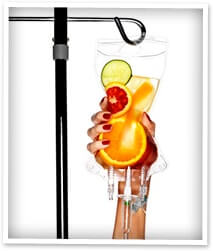
Vitamin C IV treatment: This is something that is done at Sanoviv, and we are to get hubby’s calculated Vitamin C blood saturation. How this apparently works is that your target saturation is 350 nanograms/milliliter. So each time you do the IV, they will test to see how much they have to give you to get you to this ultimate saturation. If you get the IV and afterwards you’re only up to 150, next time they will give you more, until they know exactly what it takes to get you to 350 nanograms/milliliter. We are to bring that back, and then continue with this protocol.
Vitamin C + Doxycycline: There have been a number of published protocols of adding doxycycline (pills) during the Vitamin C IV, to deal with cancer stem cells. It has recently been shown that, like heart stem cells, bone stem cells, etc. there are actually cancer stem cells. Unfortunately, they are not responsive to chemotherapy. If you happen to hit one with radiation or cut one out with surgery then it’s gone – but the only systemic treatment for cancer (chemo) doesn’t kill them. Unfortunately, at some point the cancer stem cells “wake up, look around” and realize that there is no cancer in the body – and then busily start to make it. Vitamin C plus doxycycline is the latest leading edge fight against cancer stem cells. Although doxycycline wipes our your gut biome, etc., it’s a trade off that could be worth it, in the short term, as the Vitamin C IV taken with doxycycline is showing in trials to kill the cancer stem cells. Unfortunately you can’t just “get doxycycline over the counter” in the U.S., so if we are able to obtain any in an international pharmacy we should go for it – otherwise, try to see if the doctor at Sanoviv will add this to the Vitamin C IV protocol.

OM85 (“Broncho-vaxom”): This is an immunostimulant used with young children and old folks basically everywhere BUT the United States for lung issues. It boosts the immune system, working to increase a person’s natural defenses against a variety of respiratory pathogens. It is an oral treatment consisting of eight different strains of (dead) bacteria, so it sort of works like a vaccine to create an immune response in the lungs. There have been a LOT of papers written about it recently, in relation to potential uses in lung cancer, and OM85 is likely over-the-counter in Mexico. About a decade ago, an Italian cancer doctor published that 7.5 mg/day (10 days on, a month off, for 3 months) worked as a treatment for lung cancers. (NOTE: I did some internet sleuthing to try to find the article and link it, but without the name, came to a dead end.)
Beating Cancer
The way to look at the whole “post-cancer” situation is as follows. Think of a timeline:
—————X->->->——————–Y->->->->—————–
X is where your immune system is. Y is where the cancer is. Each is moving forward, but if you can’t close the gap, you’re never actually well. “Catching up” is not the same as “Caught up.” This is the biology of how things work.
Western medicine basically says “We will buy you time, as you catch up.” In other words, they knock out the Y with, say, chemo. The problem is, that the chemo also sets your immune system (the X) back. The issue is that Western medicine “attacks.” And “Attacking” the disease is not the same as “Preventing” the disease.
Alternative therapies try to narrow the gap. The whole idea is to get the X in FRONT of the Y. The immune system must be “competitive” and ready for anything, not always behind and just working hard to catch up.
And this means lifestyle changes.
Post-cancer life must be organized around the strategy of narrowing the gap between X and Y, with the hope of jumping the X in front of the Y. And always remember that — while “giving up” things that are suboptimal for health – having good health is not a punishment. All the suggestions here might not be what you are doing now – or might mean not doing what you “want to do” with regard to eating, drinking, exercise and the like – but, post-cancer, one must persist for at least the next couple of years along this strategy, to stay in “synch” with the idea of closing the gap between the immune system and what it’s fighting . . . and then (hopefully) getting in front of it.
The Abscopal Effect:

The Abscopal Effect has been proven in trials and double-blind studies. It is a combination of radiation and immunotherapy wherein treating a cancer causes untreated tumors to disappear or shrink concurrently, outside the scope of the treatment. This has particularly been seen when Stereotactic Radiosurgery (“SRS” or “cyberknife”) treatments are the “radiation” part of the equation.
Cyberknife plus Immunotherapy leads to a systemwide immune response. The question is how to make this happen. Western medicine is trying to use various methods:

a. CAR T Cells: In this protocol, T-cells (“fighter” cells) are taken out of the patient’s body and modified to produce specific structures called chimeric antigen receptors (CARs). Basically, they take your T-cells and expose them to your cancer, rewarding them for attacking that cancer. Then these fighters are grown and re-injected in the 100s of millions back into you. This has led to the most durable remissions.
b. USC/Victor Longo: This is the fasting program that I discussed in my previous blog. It is basically a three-day water fast. In trials, what happens is this: During the 1st day, your body fights you (“Eat, Eat, EAT you IDIOT, I’m HUNGRY!”). On the 2nd day, your body’s “cleaner” cells cleans up anything that they see that is “easy to clean up,” because they don’t have any digesting, etc. to do. Then, the third day is the charm. On the third day, all the easily-cleaned things are cleaned up, there’s still no digestion going on, and so your “cleaner cells” go back over everything, and start going after older immune cells, terminating them. Think of it this way:
Cancer Cell
—X1—>—X2—->—X3—>—X4—>—X5—>—X6—>
In the example above, the T cells (X1 to X6) flow past the cancer cell. T-cell X5 is a month or so old, and a few days from being terminated by the body. X4 is only a day old. X4 is a “new, aggressive fighter.” X4 says to X5, which has passed the cancer by, “Hey, isn’t that a suspicious cell?” The X5 cell says “Yeah Sonny, I see it, but it’s a big body out there, and we have other things to do. We’ll attack it later.” But then it doesn’t. Since the T-cells speak to one another, the X4 has just “learned” from the X5 that it’s “not that important” to attack the cancer cell.
In the fasting protocol (and actually also the trained CAR T-Cells mentioned above), old cells like X5 are wiped out – so the newbie X4 cell doesn’t learn to “not attack” the cancer cell (or, in the CAR T-cell protocol, is specifically taught TO attack that cell). This means that the new T-cells work more effectively against the cancer.
While the USC/Longo/3 day fast protocol DOES drop your immunity a bit, the next day, when you start eating again, the trials have shown an unprecedented reboot of the T-cells and their ability and desire to fight the cancer.
There is also a “5 day fast-mimicking diet” for folks who just won’t do a 3-day water fast. But as my hubby did it during chemo, and the actual 3 day total fast protocol is the one being shown to have the best effect, we should presume that this becomes part of our long-term protocol.
USC/Longo recommends that every day you have a 14-hour interval of not eating/drinking (except water). While some are pushing this to 16 hours (in other words, an 8-hour eating “window”), the studies have been done on the 14 hour interval. Since Sanoviv operates on this schedule, this needs to be the “after Sanoviv” protocol for eating/drinking. THEN, every week, one day a week, have breakfast, then do a 24-hour water fast until the next breakfast. Just pick a day and do it. (Or dinner to dinner – whatever.) Finally, every 7-10 weeks, do the full 3-day protocol. This is what the research shows is optimal for killing the most cancer cells and revitalizing T-cells to their “fighting best.” Just pick the days, put them on the calendar, and get them done.
In sum: 14 hour daily interval of no eating, no drinking except water (or you can see it as a “10 hour eating window”). One day a week, eat a meal (e.g., breakfast), then just water to the same meal (e.g., breakfast) 24 hours later. Once every 7-10 weeks, full 3 day water fast.
While the Abscopal Effect was incredibly important to try to obtain, unfortunately, as the SRS treatment was being done via our traditional Western medical situation, the Chief was unable to get the permissions to even do a “trial of 1” using the SRS with one of the additions above. Just not enough time to get it “through the system.” If, however, someone reading this is interested, the interventional radiologist Dr. Jeanne Stryker in Solana Beach does SRS/cyberknife plus immune therapy using either Keytruda or Optivo.
Supplements: Broffman prescribed a host of supplements for the SRS (as he had during chemo). We will receive an abbreviated protocol for the time that we’re at Sanoviv and when we return, he will re-evaluate. I would say what was prescribed, but I don’t feel comfortable doing that. If you’re in a situation where you want to explore ways to use integrative medicine for fighting what ails you or just reaching optimal health, please consider contacting Broffman at Pine Street. He has clients internationally, and in my opinion (as your first visit is about 90 minutes) is incredibly inexpensive for what you get ($500 for the first consultation and then any follow-on supplement changes, etc. – if your situation changes drastically and you need another full consultation, $400 for each). And – yes – they take plastic.
Fitness:

a. Strength. Hubby needs to be doing strength work at least 30 minutes, 2x/week. Broffman likes the “Super Slow” protocol, which uses ARX equipment. Unfortunately, this is only available in San Francisco and Emeryville. There is a place in Mill Valley that uses MRX equipment, the pre-ARX equipment. ARX hasn’t caught on so much, because you have to lease it – you can’t own it like MRX. “Super Slow” was originally proposed by Arnold Schwartzenegger – i.e., having resistance in both parts of a lift. By way of example, pressing up in a bench press, but having another person there that is then “pulling up” on the bar when you’re trying to put it back down to your chest. See HERE for example. Hubby needs to concentrate on putting mass on, which is active tissue that will work for you, versus fat – and especially “toxic fat” – which works against you.
b. Walking. At least one day a month of “long slow distance” walking is required. This means walking, for example, from home to San Francisco, and taking the ferry back. This should take a few hours. This will become a meditation – you “stop talking in your head” and just walk. Hubby is to keep doing the “quicker” (30 minutes) or “mid-range” (hills) daily, but needs to incorporate a long-slow distance once a month too upon returning from Sanoviv. As he is currently on disability, this needs to be his “work.”
c. Swimming. Broffman particularly recommends taking a “holistic swimming” class. This is run by Russ Monsell in Tiburon of DynamicVitality.com on Tuesdays – you show up with money, a bathing suit, and a towel and he will run you through the basic/beginner class. The idea is that swimming is very helpful to your immune system, but ONLY if you’re not constantly fighting it. We are not “meant to” live in the water, and our system knows it, so is constantly, in the background, “fighting” it. The idea is to develop breathing and stroke dynamics that mimic what a creature that really lives in the water will do. No neck movement – just roll to breathe – low kicking – etc. This has been proven to immensely improve the immune system; however, it is relaxing at an immune level only if you are not defensive. You must “swim like a marine mammal” not like a “land mammal.” Your body has to think “I live here in the water.” Swim for meditative cardio.
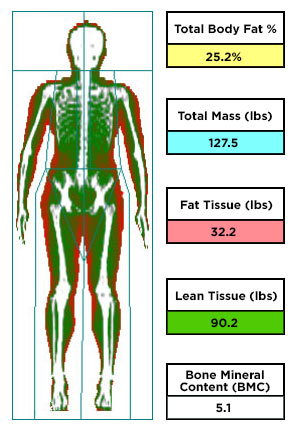
d. Baseline. Upon returning from Sanoviv, we are to get a baseline of skeletal muscle, fat (brown v white), etc. The company that does this, BodySpec, uses a modified DEXA scan. It is $45, and will give you metrics that you can then try to improve upon. It is on Broadway in San Francisco. They also have a mobile van that they take out sometimes, but the best metrics in the Bay Area are from this company.
The idea here is to have a baseline so that you can see as you make yourself more competitive with the disease – as you “catch” the X “up to” the Y, with the goal of “jumping” it.
Stress Reduction:
This is another mandated piece.

a. Meditation. Broffman particularly likes the 10 day meditation routine retreat offered free worldwide from DHAMMA.org. The closest to us is in Yosemite in North Fork. It is the same program worldwide, just different languages. At the retreat, you are introduced to the “technology” of meditating. It is a silent retreat, Vipasenna style. It is an extremely popular program, however, so getting on their list is important. They will send out when the enrollment will “open” for the program, and it is full with a long waiting list 2 hours later.
Another suggestion locally is the Sonoma Mountain Zen Center. On Saturdays, they are open to the public. They are similar to Green Gulch, but ONLY meditation (no pottery, tea classes, gardening, etc.) It’s the standard: meditation, sitting, dharma talk, soup and salad. A very pretty place, up in Sonoma, acres of farmland. The owner has run the center for decades with his wife and his kids, some of whom are monks there.
Taking A Deeper Step, and Changing the Narrative.
After you try a few of these out, your responsibility will be to figure out “What’s the next deeper step after this for me?” Just go with whatever sounds intriguing, but with the goal of “Changing the Narrative.” By way of example, there is a group in Santa Cruz called 1440 Multiversity. 1440 is the number of minutes in a day. They have a protocol for “optimizing” the minutes. However, he finds it stressful to think of it this way – as in “don’t waste any minute!” Perhaps instead, think of it as how many hours you have in a week – block out when you’re going to be eating, sleeping, walking, fasting, yoga, meditating, whatever – and then calendar, and stick to it like it’s your job, to be sure that you “do them all” and don’t let anything slide, at least for the next 24 months. This often happens. You need to keep the goal in mind of “jumping the Y” – in other words, to get your whole “being” in “front of” the cancer instead of trying to catch up, or doing things that are suboptimal for the best health, which sets you back as your body rids itself of whatever you just did. (You know, the fun things like drinking wine and eating red meat!)
Changing The Narrative:
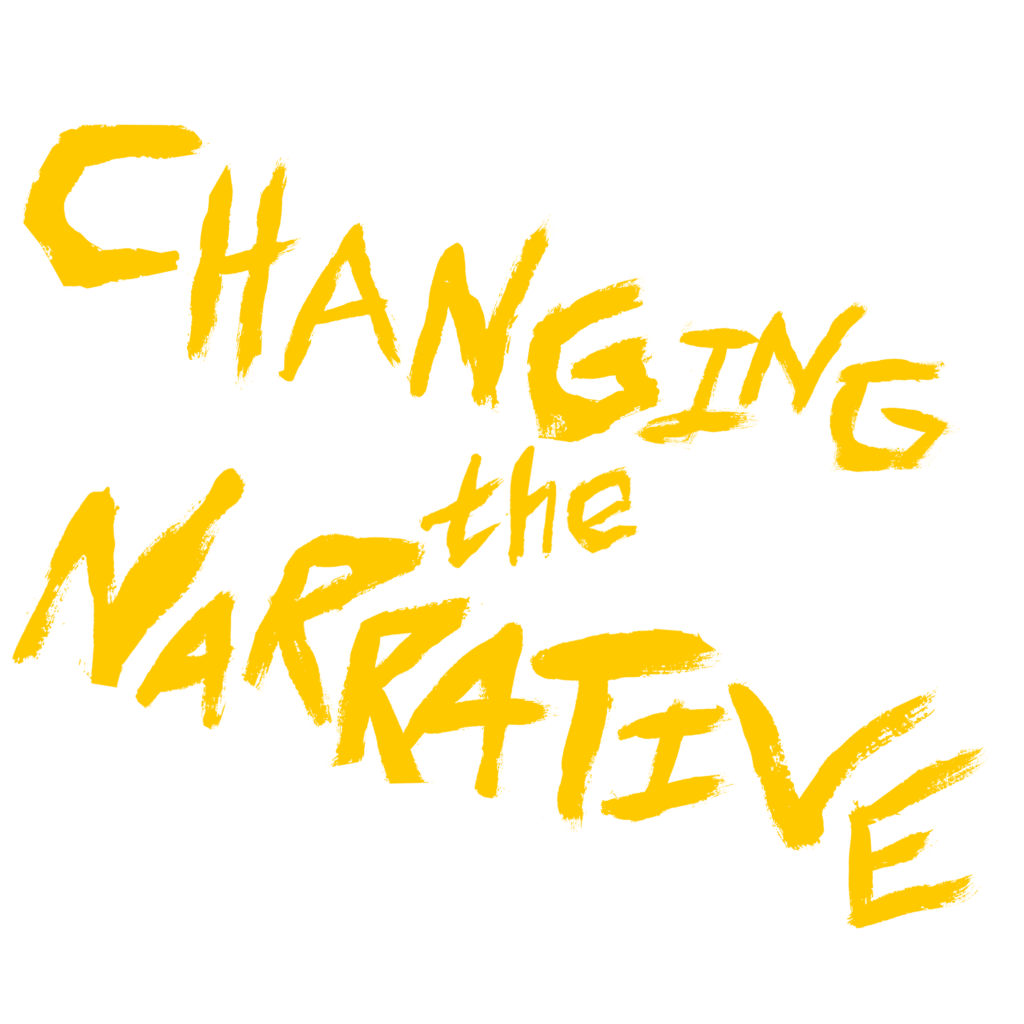
If you change any aspect of an adverse story, it will affect your immune system. (Example: If you address what’s behind PTSD to help the body/mind to stop fighting that, the body can then move on to fight other things.) Changing the narrative affects the immune system and your entire micro-environment. And chronic stress (caused by thoughts or “dwelling on an unproductive narrative”) are particularly bad.
So how do you get a New Story? It has been clinically proven that Chemistry follows Thoughts . Stressful thoughts -> Stressful chemistry -> Bad things happen. Change the story? Change the chemistry.
Psychoactive plants: While meditation practice can be helpful, the biggest jump start that is being trialed now is using psychoactive plants/chemicals. Johns Hopkins is currently the leading researcher in this area, and they are comparing synthetic versions of chemicals (psilocybin, LSD, iowaska) with the “plant” versions. The reason that using a synthetic version is preferred is (a) you can be absolutely positive about the dose and (b) you don’t denude the planet of all these plants. The downside is the plants may have some element in them that you miss in the synthesized version. There are some iowaska farms now, but not a lot. So to optimize, you have to go synthetic.
There was a researcher from Johns Hopkins recently who spoke in Mill Valley at a tiny facility and it overflowed at 400 people. He stated that they have now (a) actually quantified the “mystical experience” scientifically and (b) the dose is over 80% effective in helping people shift their internal narratives by actually having a “mystical experience.” He laid out the tenets of what a “mystical experience” is, and they then trialed whether folks were having them or not. They found that 25 mg of Ketamine produced a “mystical experience” 80% of the time. This is the only legal drug – and of course, it’s just another tool. This might be something to consider around September.
How can you tell if you’re making progress?
One of the best ways is outside observation. You want to aim for “invisibility.” You want to create an “unrecognizable person” compared to the person that harbored an environment that led to the cancer. Also think of Stoicism, and books like Essentialism — You want to stop expending energy unless it is absolutely required of you. Spending that energy means that you can’t spend it on other things (like healing).
How do you “become unrecognizable”? Imagine that there is an “A” list and a “B” list of your entire life. The “A” list contains every single experience you’ve had; the complete set of all life experiences and occurrences. It includes birth, marriage(s – for my hubby), schools, and all the genomics and epigenetics that led to cancer – plus having cancer. To create the “B” list, you just want to take things from the “A” list, but as few as possible. Let the rest go. Stop giving energy to them, give them up, and get them out of your “story.”
Let’s say that means that you bring over 3 of the 10 things that led your body to express the cancer. That’s still going to be okay – because it took all 10 to get there. The idea here is to “shed” the things from the “A” list that aren’t leading to optimal health. Remember to just think “Change is good,” even if you don’t know what that change looks like from where you’re standing in the Present.
Winter will be key. It is the season of the bladder and kidney. So this is all prep for that. Even though there is no “bladder organ” after the surgery, there is a re-built one, and there are 57 points on the bladder channel and meridian that are still active. Those come into their season in winter. So this all needs to be teed up for then.
Sleep:

This is awkward, as, with the neobladder, one has to empty the bladder every two hours (it’s not “bladder material” so if it overstretches, it doesn’t bounce back). What about substances to “Help” you sleep? When asking about using THC/CBD, we were reminded that, while THC improves the “sleep latency” (i.e., the time to fall asleep is shortened), it disrupts the actual sleep cycle. So you don’t get the same restorative/deep sleep. CBD does NOT do this. The goal here is to optimize the REM cycle. Moreover, keeping track is important, because you need to quantify to be able to see what’s working and what’s not. Perhaps find an app, or a sensor, but it is important to really see how sleep is going, and then to address issues. We’re reminded that the temperature of the room for sleep should be low 60s at the highest, and that dropping by 2 degrees F kicks sleep in. No electronics/TV, take some time on getting into bed to “review the day” and get ready to sleep – basically, have a sleep routine.
There have been studies that show that 2 hours before you “know that an alarm will go off,” you stop having quality sleep. However, if you tell someone that you will wake them up “some time” during the night (not giving them an exact time), they NEVER have REM sleep. As such, the 2 hour “alarm” to get up to void the bladder is not optimal, but it’s necessary. Reminded to ensure that it doesn’t affect my sleep. (NOTE: It usually doesn’t, but if hubby doesn’t get it right off, it WILL wake me up, and then I have to get out of bed. And hence those 4 a.m. Facebook and Instagram posts!)
So, there you go – those are my notes from our second visit to Pine Street. I also have notes from our first visit, but they’re really geared towards the particular type of cancer we were facing (as well as the phased protocol for dealing with chemotherapy), so I thought that these ones might be more universally interesting. As a final tidbit, I’d like to suggest another podcast listen: it’s 5 Ways To Heal Yourself With Dr. Kelly Turner from The mindbodygreen Podcast.
Any questions?



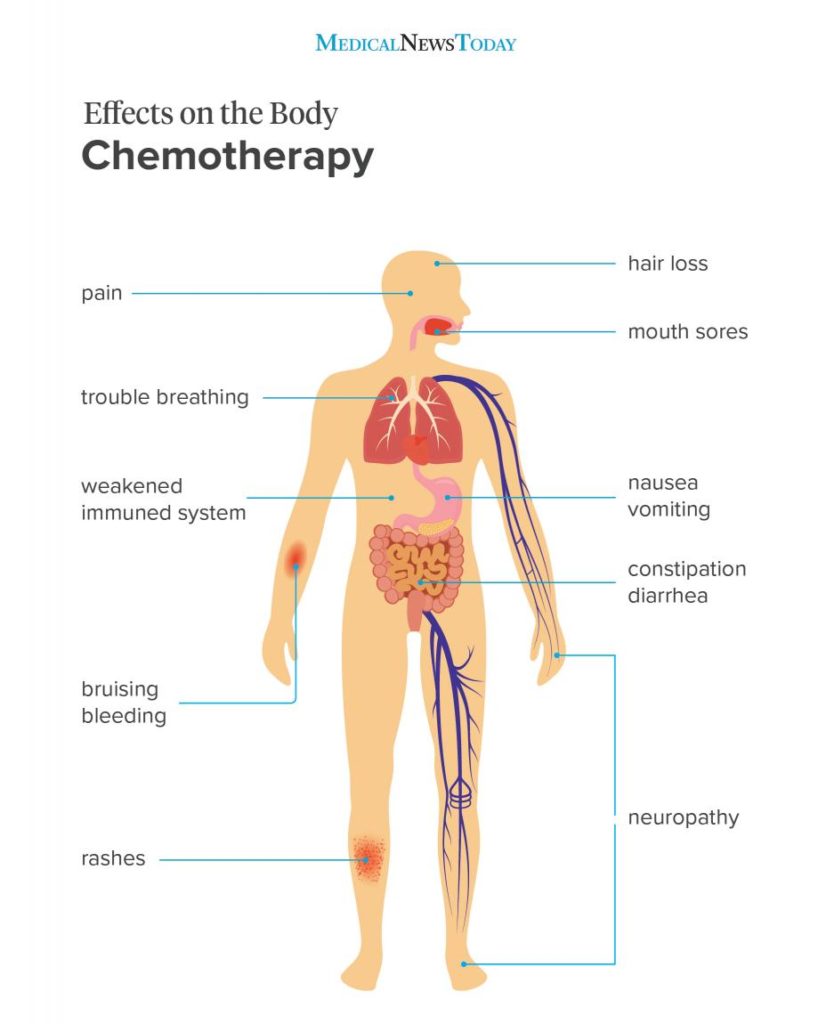

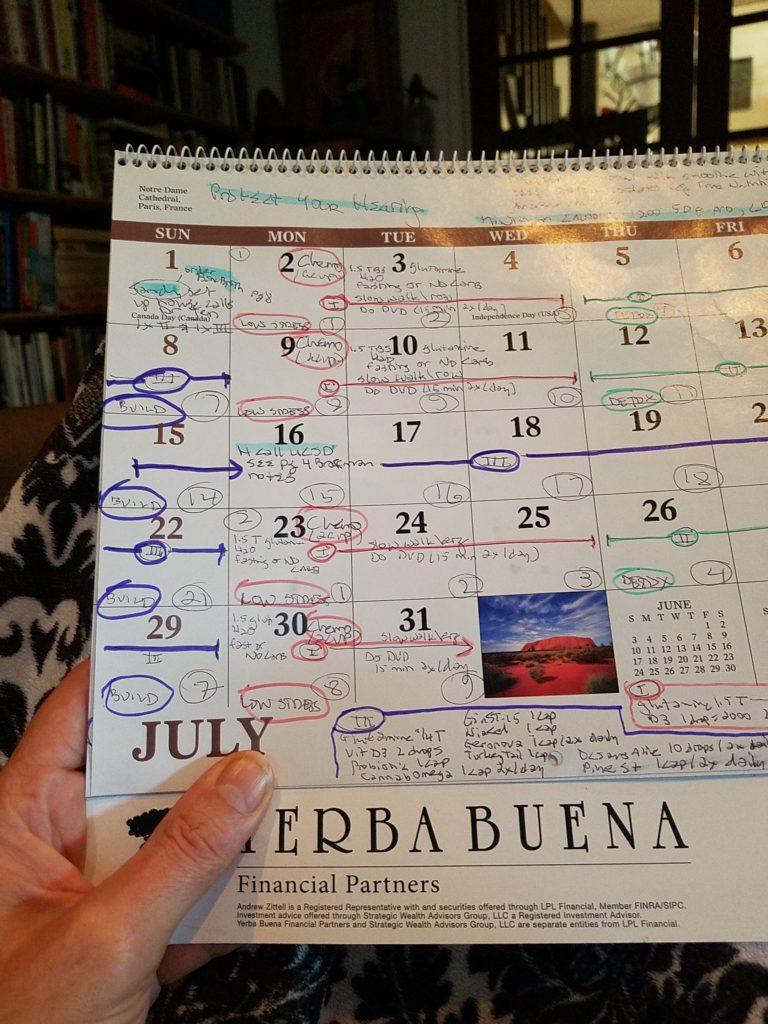
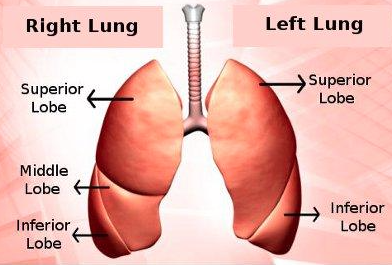



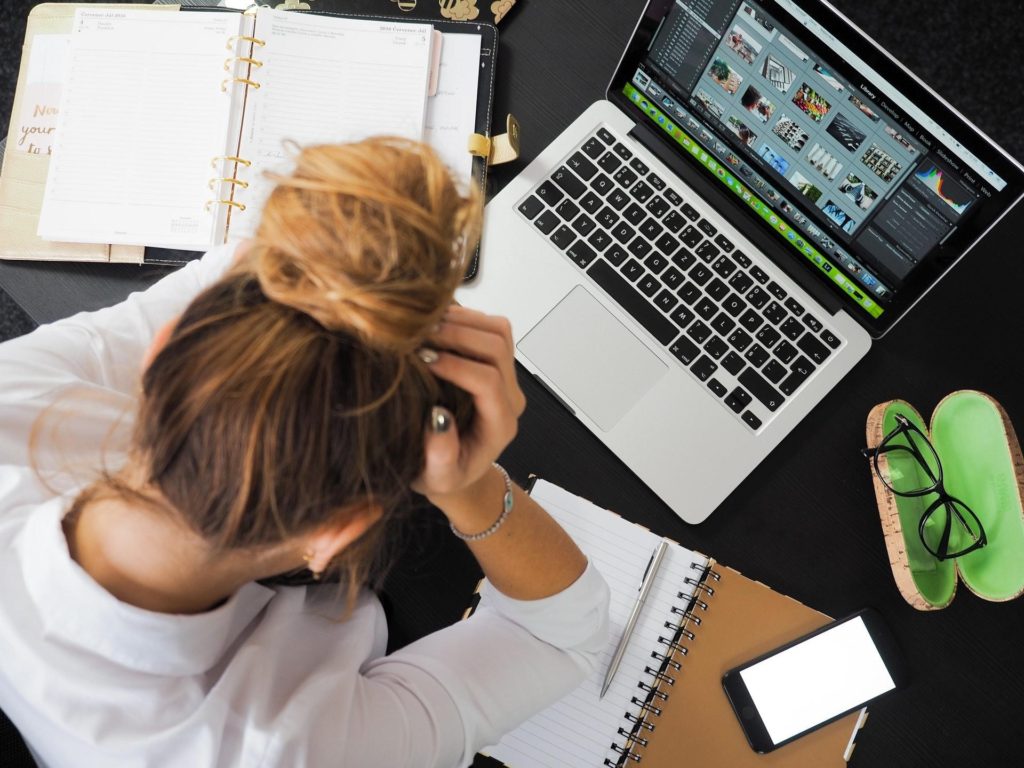
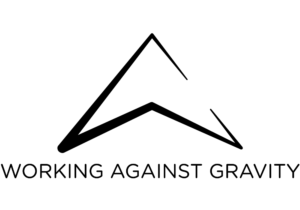


 They even have questions that ask you how much of a “high touch” experience you’re looking for. I have
They even have questions that ask you how much of a “high touch” experience you’re looking for. I have 


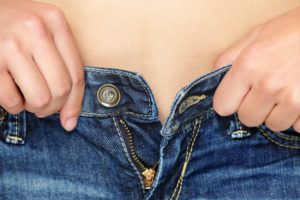











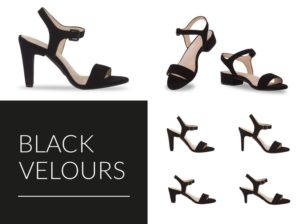

 ou’ll have your sarong to dry off!)
ou’ll have your sarong to dry off!)
